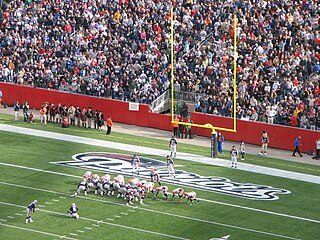 W
WThe conversion, try, or convert occurs immediately after a touchdown during which the scoring team is allowed to attempt to score one extra point by kicking the ball through the uprights in the manner of a field goal, or two points by bringing the ball into the end zone in the manner of a touchdown.
 W
WThe dead zone refers to an area on the field of gridiron football where an offense is on their opponent's side of the field, but kicking a field goal would likely be unsuccessful and punting the ball would not dramatically change field position. The dead zone may exist anywhere from the opponent's 33 to 43-yard line, where a field goal attempt would be between 50 and 60 yards and punting the ball would likely result in a touchback.
 W
WIn gridiron football double coverage is a state of defensive playcalling wherein two defensive players are assigned to "cover" one offensive player. This situation is often seen with standout wide receivers and running backs.
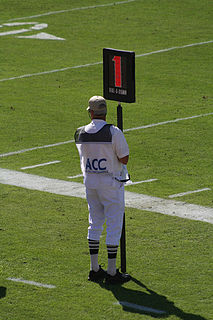 W
WA down is a period in which a play transpires in gridiron football. The down is a distinguishing characteristic of the game compared to other codes of football, but is synonymous with a "tackle" in rugby league. The team in possession of the football has a limited number of downs to advance ten yards or more towards their opponent's goal line. If they fail to advance that far, possession of the ball is turned over to the other team. In most situations, if a team reaches their final down they will punt to their opponent, which forces them to begin their drive from further down the field; if they are in range, they might instead attempt to score a field goal.
 W
WIn gridiron football, a dual-threat quarterback, also known as a running quarterback, is a quarterback who possesses the skills and physique to run with the ball if necessary. With the rise of several blitz heavy defensive schemes and increasingly faster defensive players, the importance of a mobile quarterback has been redefined. While arm power, accuracy, and pocket presence – the ability to successfully operate from within the "pocket" formed by his blockers – are still the most important quarterback virtues, the ability to elude or run past defenders creates an additional threat that allows greater flexibility in the team's passing and running game. Overall, the dual-threat quarterback has been referred to as "the most complex position in sports" by Bleacher Report.
 W
WThe end zone is the scoring area on the field, according to gridiron-based codes of football. It is the area between the end line and goal line bounded by the sidelines. There are two end zones, each being on an opposite side of the field. It is bordered on all sides by a white line indicating its beginning and end points, with orange, square pylons placed at each of the four corners as a visual aid. Canadian rule books use the terms goal area and dead line instead of end zone and end line respectively, but the latter terms are the more common in colloquial Canadian English. Unlike sports like association football and ice hockey which require the ball/puck to pass completely over the goal line to count as a score, both Canadian and American football merely need any part of the ball to break the vertical plane of the outer edge of the goal line.
 W
WA field goal (FG) is a means of scoring in gridiron football. To score a field goal, the team in possession of the ball must place kick, or drop kick, the ball through the goal, i.e., between the uprights and over the crossbar. The ball must not touch the ground or any player prior to going over the Crossbar. American football requires that a field goal must only come during a play from scrimmage, while Canadian football retains open field kicks and thus field goals may be scored at any time from anywhere on the field and by any player. The vast majority of field goals, in both codes, are place kicked. Drop kicked field goals were common in the early days of gridiron football but are almost never done in modern times. In most leagues, a successful field goal awards three points.
 W
WIn several forms of football, a forward pass is the throwing of the ball in the direction to which the offensive team is trying to move, towards the defensive team's goal line. The forward pass is one of the main distinguishers between gridiron football in which the play is legal and widespread, and rugby football from which the North American games evolved, in which the play is illegal.
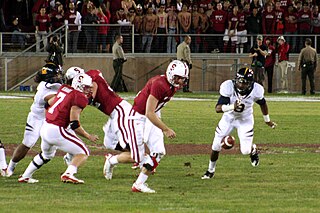 W
WA fumble in gridiron football occurs when a player who has possession and control of the ball loses it before being downed (tackled), scoring, or going out of bounds. By rule, it is any act other than passing, kicking, punting, or successful handing that results in loss of ball possession by a player.
 W
WThe goal line is the chalked or painted line dividing the end zone from the field of play in gridiron football. In American football the goal lines run 10 yards (9.1 m) parallel to the end lines, while in Canadian football they run 20 yards (18 m) parallel to the dead lines. In both football codes the distance is measured from the inside edge of the end line to the far edge of the goal line so that the line itself is part of the end zone. It is the line that must be crossed in order to score a touchdown.
 W
WA kickoff is a method of starting a drive in gridiron football. Typically, a kickoff consists of one team – the "kicking team" – kicking the ball to the opposing team – the "receiving team". The receiving team is then entitled to return the ball, i.e., attempt to advance it towards the kicking team's end zone, until the player with the ball is tackled by the kicking team, goes out of bounds, or scores a touchdown. Kickoffs take place at the start of each half of play, the beginning of overtime in some overtime formats, and after scoring plays.
 W
WIn gridiron football, a line of scrimmage is an imaginary transverse line beyond which a team cannot cross until the next play has begun. Its location is based on the spot where the ball is placed after the end of the most recent play and following the assessment of any penalty yards.
 W
WA linebacker is a playing position in gridiron football. Linebackers are members of the defensive team, and line up approximately three to five yards behind the line of scrimmage and behind the defensive linemen. They represent the "middle ground" of defenders, playing closer to the line of scrimmage than do the defensive backs, but further back than do the defensive linemen.
 W
WIn gridiron football, an onside kick is a kickoff deliberately kicked short in an attempt by the kicking team to regain possession of the ball. This is in contrast with a typical kickoff, in which the kicking team intends to give the ball to the other team and thus kicks the ball far downfield in order to maximize the distance the receiving team has to advance the ball in order to score. The risk to the team attempting an onside kick is that if it is unsuccessful and the receiving team gets the ball, the receiving team usually has a much better field position than it might have with a normal kickoff. Rules and procedures for onside kicks differ between the different codes and leagues of gridiron football.
 W
WThe place kick is a type of kicking play commonly used in American football, association football (soccer), Canadian football, rugby league, and rugby union.
 W
WIn gridiron football, a sack occurs when the quarterback is tackled behind the line of scrimmage before he can throw a forward pass, when the quarterback is tackled behind the line of scrimmage in the "pocket" and his intent is unclear, or when a passer runs out of bounds behind the line of scrimmage due to defensive pressure. This often occurs if the opposing team's defensive line, linebackers or defensive backs are able to apply pass pressure to quickly get past blocking players of the offensive team, or if the quarterback is unable to find a back to hand the ball off to or an available eligible receiver to catch the ball, allowing the defense a longer opportunity to tackle the quarterback.
 W
WReturn yards is a gridiron football statistical measure that takes several forms. In American and Canadian football, progress is measured by advancing the football towards the opposing team's goal line. Progress can be made during play by the offensive team by advancing the ball from its point of progress at the start of play known as the line of scrimmage or by the defensive team after taking possession of the football via a change of possession. When the defensive team advances the ball during play after a change in possession, yardage is credited from the point of the change of possession. Return specialists are commonly monitored statistically for their totals and averages. However, other types of return yardage such as interception return yards are also measured because the point on the field where a change in possession occurs is marked.
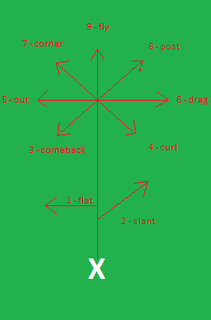 W
WA route is a pattern or path that a receiver in gridiron football runs to get open for a forward pass. Routes are usually run by wide receivers, running backs and tight ends, but other positions can act as a receiver given the play.
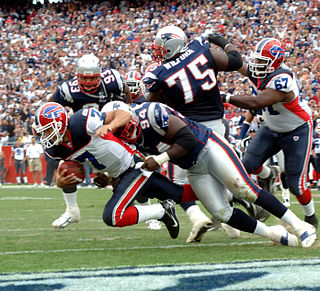 W
WIn gridiron football, the safety or safety touch is a scoring play that results in two points being awarded to the scoring team. Safeties can be scored in a number of ways, such as when a ball carrier is tackled in his own end zone or when a foul is committed by the offense in their own end zone. After a safety is scored in American football, the ball is kicked off to the team that scored the safety from the 20-yard line; in Canadian football, the scoring team also has the options of taking control of the ball at their own 35-yard line or kicking off the ball, also at their own 35-yard line. The ability of the scoring team to receive the ball through a kickoff differs from the touchdown and field goal, which require the scoring team to kick the ball off to the scored upon team.
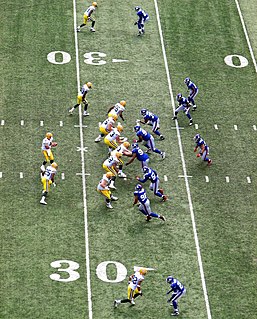 W
WThe shotgun formation is a formation used by the offensive team in gridiron football mainly for passing plays, although some teams use it as their base formation. Instead of the quarterback receiving the snap from center at the line of scrimmage, in the shotgun he stands farther back, often five to seven yards off the line. Sometimes the quarterback will have a back on one or both sides before the snap, while other times he will be the lone player in the backfield with everyone spread out as receivers.
 W
WIn Canadian football, a single is a one-point score that is awarded for certain plays that involve the ball being kicked into the end zone.
 W
WSlotback, sometimes referred to as an A-back or "slot receiver", is a position in gridiron football. The "slot" is the area between the last offensive lineman on either side of the center and the wide receiver on that side. A player who lines up between those two players and behind the line of scrimmage fills that "slot". The slotback position is a fixture of Canadian football and indoor football where they act as extra receivers. It is also used in American football where the position requires a versatile player, who must combine the receiving skills of a wide receiver, the ball-carrying skills of a running back, and the blocking skills of a tight end.
 W
WA touchdown is a scoring play in gridiron football. Whether running, passing, returning a kickoff or punt, or recovering a turnover, a team scores a touchdown by advancing the ball into the opponent's end zone.
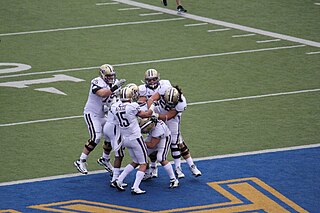 W
WIn gridiron football, touchdown celebrations are sometimes performed after the scoring of a touchdown. Individual celebrations have become increasingly complex over time, from simple "spiking" of the football in decades past to the elaborately choreographed displays of the current era.
 W
WIn gridiron football, a two-point conversion or two-point convert is a play a team attempts instead of kicking a one-point conversion immediately after it scores a touchdown. In a two-point conversion attempt, the team that just scored must run a play from scrimmage close to the opponent's goal line and advance the ball across the goal line in the same manner as if they were scoring a touchdown. If the team succeeds, it earns two additional points on top of the six points for the touchdown, for a total of eight points. If the team fails, no additional points are scored. In either case, if any time remains in the half, the team proceeds to a kickoff.